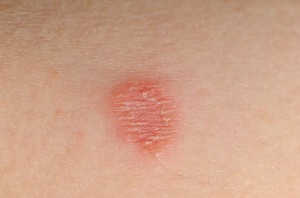Ringworm of the body is one of several forms of ringworm, a fungal infection that develops on the top layer of your skin. It’s characterised by an itchy, red circular rash with healthy-looking skin in the middle. Ringworm gets its name from the characteristic ring that can appear, but it has nothing to do with an actual worm under your skin. Also called tinea corporis, ringworm of the body is closely related to other fungal infections with similar
names, including athlete’s foot (tinea pedis), jock itch (tinea cruris) and ringworm of the scalp (tinea capitis).
Signs And Symptoms
The signs and symptoms of ringworm
include:
1. A circular rash on your skin that’s red and inflamed around the edge and healthy looking in the middle
2. Slightly raised expanding rings of red, scaly skin on your trunk or face
3. A round, flat patch of itchy skin
More than one patch of ringworm may appear on your skin, and patches or red rings of rash may overlap. You can have tinea infection without having the common
red ring of ringworm.
Causes
1. Fungal infections, such as ringworm, are caused by microorganisms that become parasites on your body. These mold-like fungi (dermatophytes) live on the cells
in the outer layer of your skin. Ringworm is contagious and can be spread in the
following ways:
2. Human to human. Ringworm often spreads by direct, skin-to-skin contact with an infected person.
3. Animal to human. You can contract ringworm by touching an animal with ringworm. Ringworm can spread while petting or grooming dogs or cats. You can also get ringworm from ferrets, rabbits, goats, pigs and horses.
4. Object to human. Ringworm can spread by contact with objects or surfaces that an infected person or animal has recently touched or rubbed against, such as clothing, towels, bedding and linens, combs, and brushes.
5. Soil to human. In rare cases, ringworm can be spread to humans by contact with infected soil. Infection would most likely occur only from prolonged contact with highly infected soil.
Treatments
For a mild case of ringworm, you can apply an over- the-counter antifungal lotion, cream or ointment. Most fungal infections respond well to these topical agents, which include:
Clotrimazole (Lotrimin AF)
Miconazole (Micatin, Micaderm)
Terbinafine (Lamisil AT)
Tolnaftate (Tinactin)
Wash and dry the affected area. Then, apply a thin layer of the topical agent once or twice a day for at least two weeks, or according to package directions.
Extend the application about an inch beyond the visible edge to ensure the best treatment. If you don’t see an improvement after four weeks, see your doctor.



